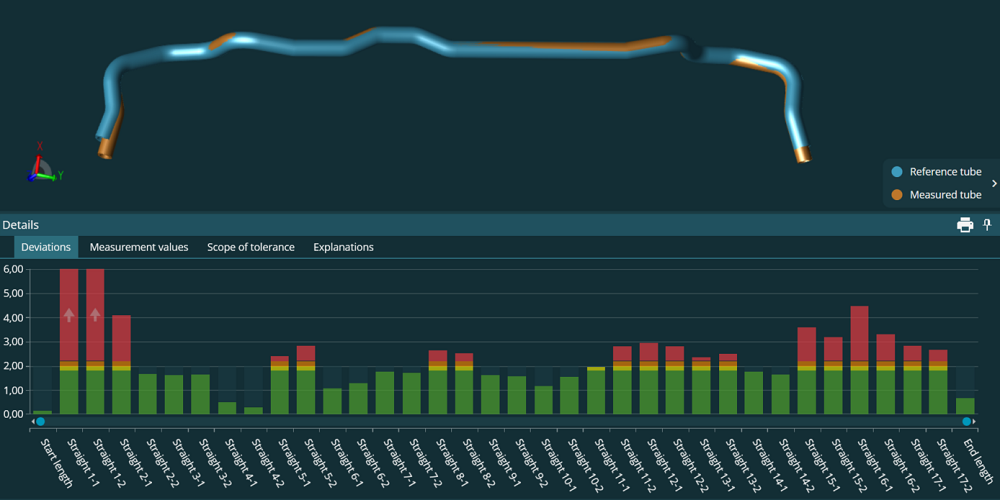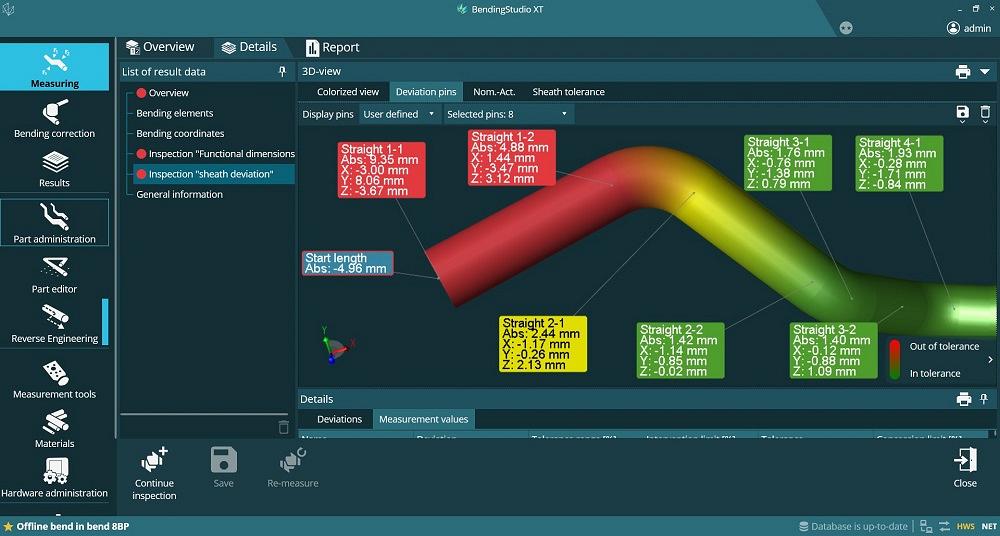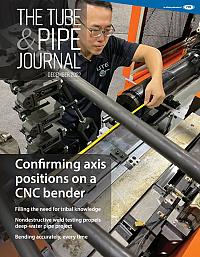Editor
- FMA
- The Fabricator
- FABTECH
- Canadian Metalworking
Categories
- Additive Manufacturing
- Aluminum Welding
- Arc Welding
- Assembly and Joining
- Automation and Robotics
- Bending and Forming
- Consumables
- Cutting and Weld Prep
- Electric Vehicles
- En Español
- Finishing
- Hydroforming
- Laser Cutting
- Laser Welding
- Machining
- Manufacturing Software
- Materials Handling
- Metals/Materials
- Oxyfuel Cutting
- Plasma Cutting
- Power Tools
- Punching and Other Holemaking
- Roll Forming
- Safety
- Sawing
- Shearing
- Shop Management
- Testing and Measuring
- Tube and Pipe Fabrication
- Tube and Pipe Production
- Waterjet Cutting
Industry Directory
Webcasts
Podcasts
FAB 40
Advertise
Subscribe
Account Login
Search
Bending tubes accurately, every time and in less time
Camera-based laser measurement tools improve quality, repeatability for Wisconsin fabricator
- By Lincoln Brunner
- December 27, 2022
- Article
- Tube and Pipe Fabrication

Sharpe Products upgraded to a larger 3D measurement machine in early 2020, vastly increasing the range of tubular products it could process.
In today’s fabrication market, agility—with turnaround time, changeovers, and time from first part to good part—often makes the difference between getting work and getting worried.
So, inspection systems that are simple to use, help to increase productivity in multiple ways, and maintain part quality aren’t just a nice add-on for companies like Sharpe Products. They’re critically important to their competitiveness.
The New Berlin, Wis., pipe and tube fabricator knows a thing or two about meeting tight customer specifications. Customers in the company’s primary markets—including aerospace, automotive, food and beverage, recreation, and medical—are famous for them. To meet those specs while maintaining speed to market, Sharpe has incorporated three different Hexagon tools—TubeInspect S and TubeInspect P16.2 3D measurement cells and an Absolute Arm 3D laser scanner.
The company uses the eight-camera TubeInspect S for its smallest jobs and the newer TubeInspect 16, with its 4- by 8-ft. work bed and 16 cameras, for all but the largest parts it produces. For those, and any others that either can’t fit into the larger machine or just prove to be easier to inspect with a scanner, it uses the Absolute Arm, which can probe or inspect almost any part from any angle.
“We primarily use the scanner because it collects much more data faster, and you’re not touching the part,” Sharpe Products Manufacturing Engineer Marshall Arndt said. “If the part is heavy enough or has some kind of fixture, you can have the potential to push the part out of the way and kind of mess up your data. So, we prefer the touchless 3D scanning. That works very well for us.”
Sharpe Products tends to focus on low- to medium-volume work rather than the high-volume production common to larger operations, according to Arndt. That’s why fast turnaround from job to job means so much.
For example, as opposed to measuring a part with a standard caliper, employees now can place tubular parts, no matter how complex, into the TubeInspect 16 and have a precise measurement in seconds.
“They’re very fast, so that helps,” Arndt said of the machines. “Sometimes, some of these complicated parts are really tricky. Say you’re laying a part out on a weld table … it’s time-consuming—if you’re even able to inspect the part that way. And then the inspection itself takes a lot longer. As long as the TubeInspect has the nominal XYZ or LRA [length, rotation, angle] data, it looks at that part, compares it to the nominal [measurements], and gives you all the deviations in a matter of seconds.
“So, that helps quick turnaround. One or two parts, that might be all it takes to proceed with production.”
That speed from part to part is augmented by the system’s BendingStudio software. For tubes falling outside acceptable deviation from the nominal specifications, it can send corrections straight to one of the company’s tube bending machines—without an operator having to enter any coordinates or other data.

Sharpe’s inspection equipment and software allow the company to record every conceivable profile of its workpieces and compare them to the nominal measurements of those parts almost instantaneously.
“Going out to the shop, everybody’s on the same page, and much faster,” Arndt said. “It’s kind of a universal language out there.”
Being able to look at the same sets of numbers across the shop has come in handy for more than one company, according to Paul Joss, product manager for Accurex, North American supplier of the TubeInspect machines. One Accurex customer had been using a more traditional method of measuring its parts but recently switched to a TubeInspect machine. After using the new system for a while, the customer noticed a stark difference.
Joss recalled the customer saying, “What I love is I no longer walk back in the shop and see three guys standing around the old measurement system, arguing about whose numbers are correct—everybody gets the same answer. It doesn’t matter. They just measure and get back to work.”
Better Collaboration
Arndt noted that Sharpe Products works with many customers to modify part designs.
During that process, using any of the testing tools at its disposal, Sharpe Products can help guide the final design process by delivering accurate data on what the part is and might be. The 3D laser scanner can scan nearly any surface with its default exposure settings and offers an extrawide scan line for improved coverage. The tool also offers high-volume data collection and can be used with both a portable arm and a laser tracker.
“Sometimes they require inspection reports or something even more in-depth to [see] what we’re able to provide to them and compare it to what they were thinking or hoping to have,” Arndt noted. “It might have to be kind of back-and-forth. It speeds up the process, and it’s easier to document.”
That documentation system in the software provides a comprehensive catalog of all the jobs done by all devices, allowing Sharpe Products to compare current parts with past jobs with a few mouse clicks. That saves on guesswork, and it helps the company adjust as needed in a fraction of the time it used to take.
“It’s really easy for us to go back and look at detailed reports that we’ve made, to compare current runs to previous runs,” Arndt said. “If the customer gets a part and they have a question about something, as long as we have inspected it on our TubeInspect or our 3D scanner, we most likely have a generated report that I can look back at and give the customer that data again if they need it.”
Joss notes that tracking data to that level and then giving customers access to it helps those customers run their operations better by providing them with more-precise parts that minimize trouble for them in their assembly operations.
“When you can have tubes coming out of your bending shop that are closer to nominal, most of those tubes end up in some sort of an assembly later,” Joss theorized. “So, if I’ve got a tube that’s very close to nominal when I weld brackets and fittings onto the end of it, I’ve got more tolerance to work with. I have better products coming out at the end because I’m not consuming all my tolerance in the first step.”

If a part is found to be out of acceptable tolerance, the software can share data with tube bending equipment in real time and make corrections without the intervention of an operator.
Simplified Living
Being able to record photos and digitized 3D images of every bend and radius in its tubes lets Sharpe Products see exactly where it is getting things right and wrong in each facet of each part it produces. Quick retrieval of that data keeps employees on the same page during production and keeps customers in the know when issues arise.
But of all those offerings, the prime benefit to Sharpe comes at the beginning of the entire production process.
“The biggest thing that impacts me is probably simplification of drawings that go out to the shop,” Arndt said. “A lot of times, I can provide basic overall dimensions, like frequency checkpoints. Otherwise, they can program the machines based off XYZ and LRA data that they also use to inspect [parts]. So, they’re looking at the same sets of numbers in the same format as a data table—their bend radius, their tangent lengths, degree of bend. All of that’s laid out in that data table, and it kind of frees up the drawing and makes the drawing process much faster.”
About the Author

Lincoln Brunner
2135 Point Blvd.
Elgin, IL 60123
(815)-227-8243
Lincoln Brunner is editor of The Tube & Pipe Journal. This is his second stint at TPJ, where he served as an editor for two years before helping launch thefabricator.com as FMA's first web content manager. After that very rewarding experience, he worked for 17 years as an international journalist and communications director in the nonprofit sector. He is a published author and has written extensively about all facets of the metal fabrication industry.
About the Publication
Related Companies
subscribe now

The Tube and Pipe Journal became the first magazine dedicated to serving the metal tube and pipe industry in 1990. Today, it remains the only North American publication devoted to this industry, and it has become the most trusted source of information for tube and pipe professionals.
start your free subscription- Stay connected from anywhere

Easily access valuable industry resources now with full access to the digital edition of The Fabricator.

Easily access valuable industry resources now with full access to the digital edition of The Welder.

Easily access valuable industry resources now with full access to the digital edition of The Tube and Pipe Journal.
- Podcasting
- Podcast:
- The Fabricator Podcast
- Published:
- 04/16/2024
- Running Time:
- 63:29
In this episode of The Fabricator Podcast, Caleb Chamberlain, co-founder and CEO of OSH Cut, discusses his company’s...
- Trending Articles
Zekelman Industries to invest $120 million in Arkansas expansion

3D laser tube cutting system available in 3, 4, or 5 kW

Corrosion-inhibiting coating can be peeled off after use

Brushless copper tubing cutter adjusts to ODs up to 2-1/8 in.

HGG Profiling Equipment names area sales manager

- Industry Events
16th Annual Safety Conference
- April 30 - May 1, 2024
- Elgin,
Pipe and Tube Conference
- May 21 - 22, 2024
- Omaha, NE
World-Class Roll Forming Workshop
- June 5 - 6, 2024
- Louisville, KY
Advanced Laser Application Workshop
- June 25 - 27, 2024
- Novi, MI


























